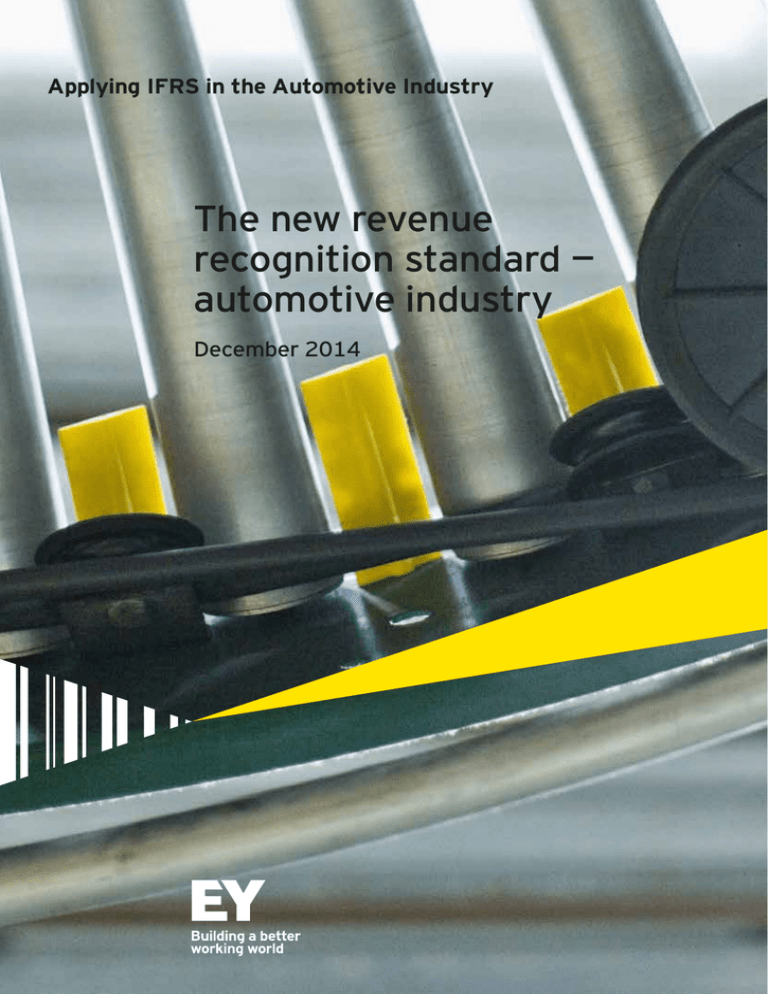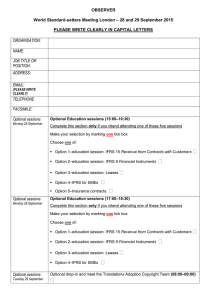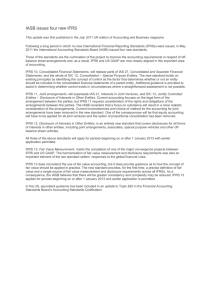
Applying IFRS in the Automotive Industry
The new revenue
recognition standard —
automotive industry
December 2014
What you need to know
• Application of the requirements of the new revenue recognition standard
will require automotive entities to use a greater degree of judgement
than they do today.
• Original equipment manufacturers and automotive parts suppliers may
identify more performance obligations than they do today.
• Automotive parts suppliers may be required to change the timing of
revenue recognition for contracts to supply customised parts.
• The standard is effective for annual periods beginning on or after
1 January 2017, with early adoption permitted.
Overview
Automotive entities may need to change certain revenue recognition practices
as a result of the new revenue recognition standard, IFRS 15 Revenue from
Contracts with Customers, that was jointly issued by the International
Accounting Standards Board (the IASB) and the Financial Accounting Standards
Board (the FASB) (collectively, the Boards). The new standard will supersede
virtually all revenue recognition requirements in IFRS and US GAAP.
IFRS 15 provides accounting requirements for all revenue arising from
contracts with customers and affects all entities that enter into contracts to
provide goods or services to their customers (unless the contracts are in the
scope of other IFRSs, such as IAS 17 Leases). The standard also provides a
model for the measurement and recognition of gains and losses on the sale of
certain non-financial assets, such as property, plant and equipment (PP&E) and
intangible assets.
Our Applying IFRS, A closer look at the new revenue recognition standard
(June 2014),1 provides an in-depth discussion of IFRS 15. This publication
summarises the key implications of the standard for automotive entities.
To support stakeholders with the implementation of the new standard, the
Boards established a Joint Transition Resource Group for Revenue Recognition
(TRG). The TRG was created to help the Boards determine whether more
application guidance or education is needed on implementation issues and other
matters submitted by stakeholders.
Separately, the American Institute of Certified Public Accountants (AICPA) has
established 16 industry task forces to help develop a new accounting guide on
revenue recognition under US GAAP and to aid industry stakeholders in
implementing the standard. A task force has not been established for the
automotive industry. Views or guidance produced by the TRG or AICPA are
non-authoritative.
The views we express in this publication are preliminary. We may identify
additional issues as we analyse the standard and entities begin to interpret it,
and our views may evolve during that process.
1
Available on www.ey.com/ifrs
December 2014
The new revenue recognition standard – automotive industry
1
Contents
Overview ............................................................................. 1
Key considerations ............................................................... 3
Incentives......................................................................... 3
Long-term supply contracts .................................................. 4
Tooling equipment ............................................................ 4
Customised parts ................................................................. 5
Repurchase options and residual value guarantees ................. 6
Next steps ........................................................................... 6
2
December 2014
The new revenue recognition standard – automotive industry
Key considerations
To apply IFRS 15, original equipment manufacturers (OEMs) will need to change
the way they evaluate incentives, and automotive parts suppliers (APSs) will
need to change the way they evaluate long-term supply contracts. Both types of
entities may need to use significant judgement when they identify separate
performance obligations (i.e., units of account), which may be different from
those identified under current IFRS. The accounting for contracts with
repurchase options or residual value guarantees may also change.
Automotive entities
may need to change
the way they account
for various incentives
as a result of IFRS 15.
Incentives
OEMs frequently offer sales incentives in contracts to sell vehicles to dealers.
These sales incentives may be cash rebate bonuses or another type of incentive
available to dealers and retail customers (who purchase the vehicle from the
dealer). They may also include free, or heavily discounted, goods or services
provided to retail customers, such as a free satellite radio or free maintenance
for a specified period.
Under IFRS 15, cash incentives (i.e., cash, credits or other items that can be
applied against amounts owed to the OEM) paid by the OEM to customers
(dealers and retail customers) will generally be treated as a reduction of the
transaction price and, therefore, of revenue. However, in some cases, the
payment to the customer is in exchange for a distinct good or service that the
customer transfers to the OEM. If the OEM is able to reasonably estimate the
fair value of the distinct good or service transferred by the customer, the OEM
accounts for that purchase in the same way it accounts for other purchases
from suppliers. This is similar, but not identical, to current IFRS. As such, OEMs
will need to evaluate whether the new standard changes the accounting
treatment for its cash incentive programmes.
Under IFRS 15, incentives, whether directly from the OEM to retail customers
or indirectly through dealers, providing free or discounted goods will likely
represent promised goods or services (i.e., revenue elements), rather than
marketing incentives. An example of such indirect incentives is free
maintenance services performed by a dealer for which the OEM provides
reimbursement. The Boards’ concluded that, even if such incentives are not
explicit promises in a contract, they would, nonetheless, be an implied promise
if the OEM has a customary business practice that results in the retail customer
having a valid expectation that the OEM is obligated to provide the maintenance
services. Therefore, such amounts are considered as promises in the contract
and the OEM will be required to account for the free services as a revenue
element.
Treating a free good or service as a separate revenue element may be a change
in practice for some OEMs. In addition, OEMs will have to review their processes
for estimating rebates and other forms of variable consideration to make sure
they fully address the new requirements for estimating the transaction price
(and applying the constraint) and appropriately document their conclusions.
December 2014
The new revenue recognition standard – automotive industry
3
Long-term supply contracts
Tooling equipment
APSs commonly enter into long-term arrangements with OEMs to provide
specific parts, such as seat belts or steering wheels. An arrangement typically
includes the construction for the tooling, which is required to be used when
manufacturing the parts to meet the OEM’s specifications. In many cases, the
APS will construct and transfer the legal title for the tooling to the OEM after
construction, even though they will retain physical possession of it in order to
produce the parts.
Currently, some APSs account for tooling as a revenue element because they
have concluded it is a deliverable in the arrangement. Those APSs will likely be
able to reach the same conclusion under IFRS 15, because the Boards
concluded that these goods and services are goods or services for which the
customer pays and to which the entity allocates consideration (i.e., identifies as
separate performance obligations) for revenue recognition purposes.
Other APSs may have concluded that tooling is not a revenue element under
current IFRS because it does not represent a deliverable in the arrangement. In
order to reach the same conclusion under IFRS 15, APSs will need to conclude
that the tooling does not transfer a good or service to the customer, similar to
administrative tasks performed by a service provider to set up a contract. It is
not clear whether this interpretation will be permitted under the standard. As
contract terms can vary, careful consideration of the APS’s terms with its
customers will be necessary in order to make this determination.
Under IFRS 15, if the tooling is determined to be a revenue element, the entity
must first evaluate whether the tooling is distinct (i.e., both capable of being
distinct and distinct within the context of the contract) and, therefore, a
separate performance obligation. In making this evaluation, an APS will have to
consider whether the tooling is separately identifiable from the production of
the specified parts (e.g., is the tooling highly dependent on, or highly
interrelated with, the production of the specified parts?). APSs will have to
apply significant judgement in making these determinations.
An entity recognises revenue when it transfers control of the promised good or
service to the customer, which can occur over time or at a point in time. If the
tooling is distinct, an APS would account for the tooling separately from the
production of the other specialised parts. Revenue would be recognised for the
tooling either over time or at a point in time, depending on how control of the
tooling transfers to the OEM. If the tooling is not distinct, the APS would
combine the tooling with the production. Revenue would be recognised as
control of the specialised parts is transferred to the OEM. This evaluation will
require judgement and careful consideration of the facts and circumstances.
4
December 2014
The new revenue recognition standard – automotive industry
Customised parts
APSs may be required
to change when they
recognise revenue for
supplying customised
parts.
Under their supply agreements, an APS may provide OEMs with a customised
part (e.g., a car seat) that is designed and constructed specifically to fit within a
particular make and model of vehicle. In these types of arrangements, APSs will
have to carefully consider whether each individual part is a separate
performance obligation or whether all the parts supplied in the contract (or
some combination of them) are considered a single performance obligation.
After the performance obligations are identified, APSs will also need to evaluate
whether the performance obligations meet the criteria for recognising revenue
over time (rather than at a point in time, such as when delivery occurs).
The Boards concluded that, when an entity is creating something that is highly
customised for a particular customer, which may be the case in an APS
contract, it is less likely that the entity could use that asset for any other
purpose. When determining whether an asset has alternative use, IFRS 15
states that an entity needs to consider the effects of contractual restrictions
and practical limitations on the entity’s ability to readily direct that asset for
another use (i.e., sell it to a different customer). A contractual restriction needs
to be substantive (i.e., the customer could enforce its rights to the promised
asset if the entity directed the asset for another use). A practical limitation only
exists if an entity would incur significant economic losses to direct the asset for
another use. An APS may need to consider these concepts in the context of
selling customised parts to an after-market supplier. The evaluation of whether
an asset has alternative use will require significant judgement.
APSs will also have to evaluate whether they have an enforceable right to
payment for performance completed to date, considering the terms of the
contract and any applicable laws or regulations. IFRS 15 states that the right to
payment for performance completed to date need not be for a fixed amount.
However, at any time during the contract term, an entity must be entitled to an
amount that at least compensates it for performance completed to date. This
applies even if the customer can terminate the contract for reasons other than
the entity’s failure to perform as promised.
The APS may need to change the timing of the recognition of the revenue from
the customised parts under IFRS 15. If the APS’s performance does not create
an asset with alternative use to the APS and the APS has an enforceable right
to payment for performance completed to date, the APS is required to
recognise revenue associated with the supply of customised parts over time
(i.e., as production occurs), rather than at a point in time (i.e., when production
is complete or when delivery takes place). This change in the timing of revenue
recognition for the customised parts could be significant.
December 2014
The new revenue recognition standard – automotive industry
5
Repurchase options and residual value
guarantees
OEMs may sell vehicles with a repurchase option or a residual value guarantee
(e.g., when they sell fleets to rental car companies). Under a residual value
guarantee, OEMs agree to compensate the customer (‘make whole’) for the
difference between the resale price the customer obtains in an open market and
the guaranteed minimum resale value.
Under IFRS 15, arrangements with repurchase features must be evaluated to
determine whether they represent a sale, lease or financing, based on specified
criteria. This evaluation includes considering factors such as the likelihood of a
customer exercising a put option or the relationship between the repurchase
price and the market value of the asset at the date of repurchase. Contracts
that include residual value guarantees and make whole provisions may qualify
for sale accounting under the revenue standard and also may include a
component of variable consideration. These assessments will require
considerable judgement.
Next steps
Automotive entities should perform a preliminary assessment of how they will
be affected by IFRS 15 as soon as possible so they can determine how to
prepare to implement the new standard. While the effect on entities will vary,
some may face significant changes in revenue recognition. All entities will need
to evaluate the requirements of the new standard and make sure they have
processes and systems in place to collect the necessary information to
implement the standard, even if their accounting results will not change
significantly.
Automotive entities may also wish to monitor continued discussions of the
Boards and the TRG.
Entities should also consider how they will communicate any changes with
investors and other stakeholders. This includes their plan for disclosure of the
effects of new accounting standards which are issued, but not yet effective, as
required by IAS 8 Accounting Policies, Changes in Accounting Estimates and
Errors.
6
December 2014
The new revenue recognition standard – automotive industry
EY | Assurance | Tax | Transactions | Advisory
About EY
EY is a global leader in assurance, tax, transaction and advisory services.
The insights and quality services we deliver help build trust and confidence
in the capital markets and in economies the world over. We develop
outstanding leaders who team to deliver on our promises to all of our
stakeholders. In so doing, we play a critical role in building a better working
world for our people, for our clients and for our communities.
EY refers to the global organization, and may refer to one or more, of the
member firms of Ernst & Young Global Limited, each of which is a separate
legal entity. Ernst & Young Global Limited, a UK company limited by
guarantee, does not provide services to clients. For more information about
our organization, please visit ey.com.
About EY’s International Financial Reporting Standards Group
A global set of accounting standards provides the global economy with
one measure to assess and compare the performance of companies. For
companies applying or transitioning to International Financial Reporting
Standards (IFRS), authoritative and timely guidance is essential as the
standards continue to change. The impact stretches beyond accounting
and reporting, to key business decisions you make. We have developed
extensive global resources — people and knowledge — to support our clients
applying IFRS and to help our client teams. Because we understand that
you need a tailored service as much as consistent methodologies, we work
to give you the benefit of our deep subject matter knowledge, our broad
sector experience and the latest insights from our work worldwide.
© 2014 EYGM Limited.
All Rights Reserved.
EYG No. AU2786
ED None
In line with EY’s commitment to minimise its impact on the environment, this document
has been printed on paper with a high recycled content.
This material has been prepared for general informational purposes only and is not intended to be
relied upon as accounting, tax, or other professional advice. Please refer to your advisors for specific
advice.
ey.com


